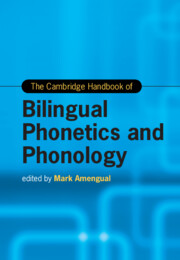Book contents
- The Cambridge Handbook of Bilingual Phonetics and Phonology
- Cambridge Handbooks in Language and Linguistics
- The Cambridge Handbook of Bilingual Phonetics and Phonology
- Copyright page
- Dedication
- Contents
- Figures
- Tables
- Contributors
- Acknowledgments
- Introduction Bilingual Phonetics and Phonology
- Part I Approaches to Bilingual Phonetics and Phonology
- Part II Theoretical Models of Bilingual Phonetics and Phonology
- 7 The Perceptual Assimilation Model: Early Bilingual Adults and Developmental Foundations
- 8 The Second Language Linguistic Perception Model
- 9 The Automatic Selective Perception Model
- 10 The Ontogeny Phylogeny Model
- 11 Bilingual Speech and Exemplar Theory
- Part III The Phonetics and Phonology of the Bilingual Child
- Part IV The Phonetics and Phonology of the Bilingual Adult
- Part V The Diversity of Bilingual Speakers
- Part VI Variables and Outcomes of Bilingual Speech
- Index
- References
8 - The Second Language Linguistic Perception Model
from Part II - Theoretical Models of Bilingual Phonetics and Phonology
Published online by Cambridge University Press: 14 November 2024
- The Cambridge Handbook of Bilingual Phonetics and Phonology
- Cambridge Handbooks in Language and Linguistics
- The Cambridge Handbook of Bilingual Phonetics and Phonology
- Copyright page
- Dedication
- Contents
- Figures
- Tables
- Contributors
- Acknowledgments
- Introduction Bilingual Phonetics and Phonology
- Part I Approaches to Bilingual Phonetics and Phonology
- Part II Theoretical Models of Bilingual Phonetics and Phonology
- 7 The Perceptual Assimilation Model: Early Bilingual Adults and Developmental Foundations
- 8 The Second Language Linguistic Perception Model
- 9 The Automatic Selective Perception Model
- 10 The Ontogeny Phylogeny Model
- 11 Bilingual Speech and Exemplar Theory
- Part III The Phonetics and Phonology of the Bilingual Child
- Part IV The Phonetics and Phonology of the Bilingual Adult
- Part V The Diversity of Bilingual Speakers
- Part VI Variables and Outcomes of Bilingual Speech
- Index
- References
Summary
In this chapter, we thoroughly describe the L2LP model, its five ingredients to explain speech development from first contact with a language or dialect (initial state) to proficiency comparable to a native speaker of the language or dialect (ultimate attainment), and its empirical, computational, and statistical method. We present recent studies comparing different types of bilinguals (simultaneous and sequential) and explaining their differential levels of ultimate attainment in different learning scenarios. We also show that although the model has the word “perception” in its name, it was designed to also explain phonological development in general, including lexical development, speech production, and orthographic effects. The chapter demonstrates that the L2LP model can be regarded as a comprehensive theoretical, computational, and probabilistic model or framework for explaining how we learn the phonetics and phonology of multiple languages (sequentially or simultaneously) with variable levels of language input throughout the life span.
Keywords
- Type
- Chapter
- Information
- The Cambridge Handbook of Bilingual Phonetics and Phonology , pp. 173 - 195Publisher: Cambridge University PressPrint publication year: 2024

